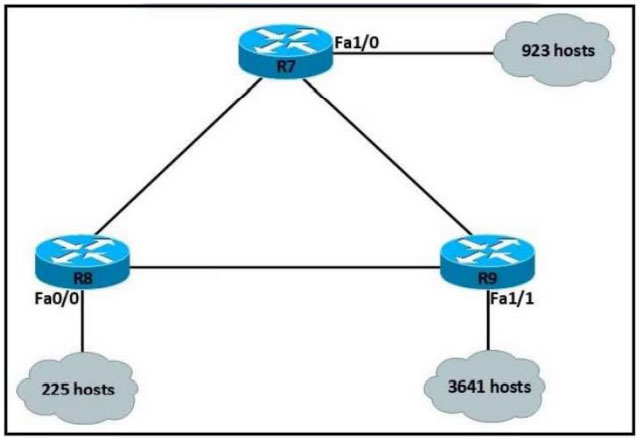
Refer to the exhibit. An IP subnet must be configured on each router that provides enough addresses for the number of assigned hosts and anticipates no more than 10% growth for new hosts. Which configuration script must be used?
A.
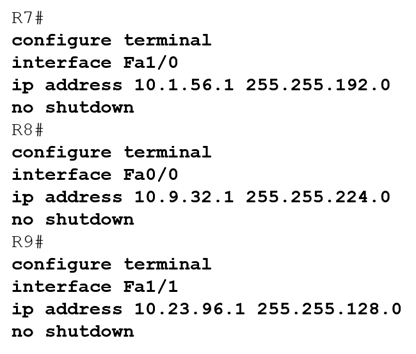
B.
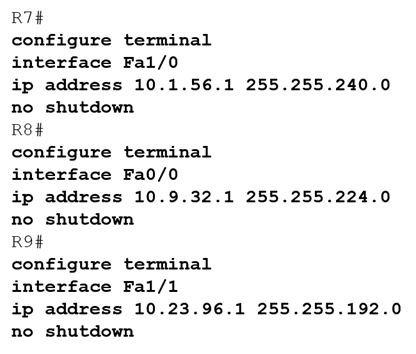
C.
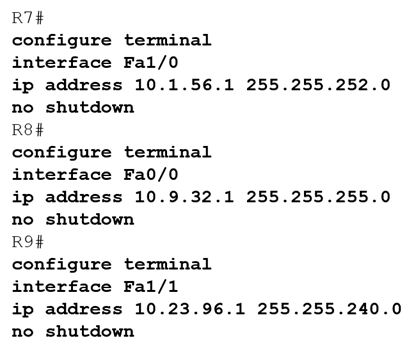
D.
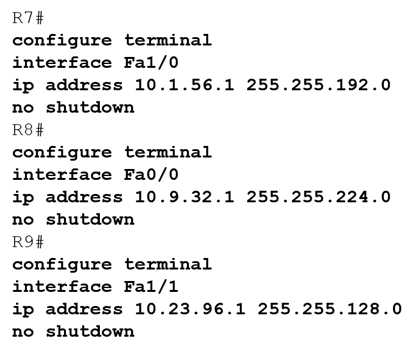

Refer to the exhibit. An IP subnet must be configured on each router that provides enough addresses for the number of assigned hosts and anticipates no more than 10% growth for new hosts. Which configuration script must be used?
A.

B.

C.

D.

To determine the correct configuration script, we need to calculate the appropriate subnet mask for each router based on the number of required hosts, including growth. The subnet mask should provide enough IP addresses for the hosts and handle a potential 10% increase in hosts. Here’s the step-by-step process for each router configuration: For R7: The network requires 923 hosts. Adding a 10% growth: 923 + 92.3 ≈ 1015 hosts. The smallest subnet that supports at least 1015 hosts is a /22 subnet. A /22 subnet provides 1024 IP addresses (2^(32-22)). The corresponding subnet mask is 255.255.252.0. For R8: The network requires 225 hosts. Adding a 10% growth: 225 + 22.5 ≈ 248 hosts. The smallest subnet that supports at least 248 hosts is a /24 subnet. A /24 subnet provides 256 IP addresses (2^(32-24)). The corresponding subnet mask is 255.255.255.0. For R9: The network requires 3641 hosts. Adding a 10% growth: 3641 + 364.1 ≈ 4005 hosts. The smallest subnet that supports at least 4005 hosts is a /20 subnet. A /20 subnet provides 4096 IP addresses (2^(32-20)). The corresponding subnet mask is 255.255.240.0. By analyzing the configuration scripts provided, we can conclude that Option C is the correct answer as it uses the necessary subnet masks: 255.255.252.0 (/22) for R7, 255.255.255.0 (/24) for R8, and 255.255.240.0 (/20) for R9. This configuration script efficiently accommodates the required number of hosts and anticipates a 10% growth for each subnet.
Can pinpoint this easily by only looking at R8: 255.255.255.0 is enough = Answer is C
by luck I looked at R8 first lol
Same, i picked the smallest one
Hahah Yeah, and when you see that there is no other option with the /24 it the answer is clear.
select the router with the lowest number of hosts, wich is r8, for 225 hosts it would be a minimun of 256 hosts wich is /24 wich is the only answer that has 255.255.255.0
Here we will do the following with no more than 10% possible growth R7 expects 923 + 92 = 1015 hosts R8 expect 225 + 23 = 248 hosts R9 expects 3641 + 364 = 4005 hosts R7 must use SM /22 at-least or less ( which gives 1022 usable IPs) R8 must use SM /24 or less (which gives 254 usable IPs) R9 must use SM /20 or less (which gives 4094 usable IPs) All answers are correct, but C uses /24 , /22 & /20 SM for router R7, R8 AND R9 respectively. C gives the most efficient use.
Remember the powers of 2 to solve the question quickly 1,2,4,8,16,32,64,128,256,512,1024,2048,4096 1015 approximated to 1024, 512 not enough 248 closest to 256 4005 closest to 4096 R7 needs 10 zeros and the rest are ones in its SM, starting from the right 11111111.11111111.11111100.00000000 >>> 255.255.252.0 R8 needs 8 zeros and the rest are in its SM 11111111.11111111.11111111.00000000 >>> 255.255.255.0 R9 needs 12 zeros and the rest are ones in its SM 11111111.11111111.11110000.00000000 >>> 255.255.240.0
Pardon me, it's /22 , /24/ 20 respectively **
just look for R7
C is Correct
C is correct
C is correct
it seems have an error in the question :A and D are same, however answer is C is correct
Calculating R7 reveals the answer. With 10% growth it makes less than 1024 hosts. That means /22 subnet which is 255.255.252.0.